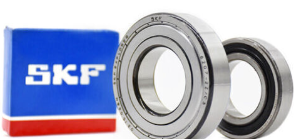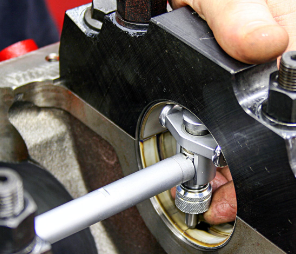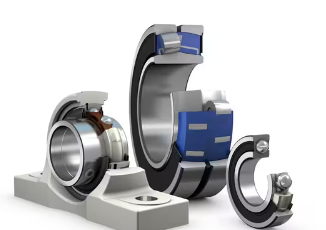Mastering SKF Bearing Tolerances: A Comprehensive Guide
Unlock the full potential of SKF bearings with our comprehensive guide to bearing tolerances.
Learn the ins and outs of bearing tolerances, from the basics to advanced techniques,
and take your bearing knowledge to the next level. Master SKF Bearing Tolerances today and optimize your equipment's performance!
Are you tired of encountering bearing failures in your industrial equipment?
Do you want to optimize the performance of your machinery and increase its lifespan?
Look no further than our comprehensive guide to mastering SKF Bearing Tolerances.
This guide will take you through the fundamentals of bearing tolerances and equip you with advanced techniques to ensure your equipment operates at peak efficiency.
Let's dive into the world of SKF Bearing Tolerances together and unlock the full potential of your machinery.
To identify the tolerances of SKF bearings, you can refer to the bearing's designation or part number.
SKF uses a standardized system for bearing designations that includes information on the bearing type, size, and tolerance class.
The tolerance class is indicated by a letter following the bearing size in the designation.
For example, the designation "6205-2RSH/C3" indicates an SKF deep groove ball bearing with a bore diameter of 25mm, a rubber seal on both sides, and a C3 clearance class.
The letter "C" indicates a radial internal clearance greater than normal and the number "3" indicates a higher tolerance class than normal.
SKF offers a range of tolerance classes, from the lowest class "Normal" to the highest class "Precision".
The tolerance class can affect the bearing's performance characteristics, such as its speed capability, operating temperature, and axial load capacity.
If you need more specific information on SKF-bearing tolerances for your application,
you can consult SKF's technical documentation or contact their technical support team for assistance.
Whether you're an engineer, technician, or maintenance professional,
understanding SKF bearing tolerances is crucial for optimizing the performance of your industrial equipment.
Our comprehensive guide to mastering SKF Bearing Tolerances will take you on a journey from the basics of bearing tolerances to the most advanced techniques.
Definition of SKF bearings

SKF bearings are high-precision machine components that are designed to support rotating shafts and reduce friction between moving parts.
SKF is a leading manufacturer of bearings, with a wide range of products including ball bearings, roller bearings, and plain bearings.
SKF bearings are known for their reliability, durability, and high performance.
They are used in a variety of industrial applications,
such as automotive, aerospace, construction, and agriculture, as well as in consumer products such as appliances and power tools.
SKF bearings are engineered to meet specific performance requirements,
such as high-speed operation, high load capacity, and resistance to extreme temperatures and harsh environments.
They are manufactured to strict quality standards and are subjected to rigorous testing to ensure their performance and reliability.
Importance of bearing tolerances in industrial applications

Bearing tolerances are critical to the performance of industrial equipment that relies on bearings to support rotating shafts and reduce friction between moving parts.
The tolerances of a bearing determine its fit and clearance within the application, which in turn affects its speed capability, operating temperature, and load-carrying capacity.
In applications that require a high-speed operation, such as in machine tools or automotive engines,
precise bearing tolerances are crucial to prevent excessive heat generation, vibration, and premature failure.
Similarly, in applications that require high load-carrying capacity, such as in heavy machinery or construction equipment,
the bearing tolerances must be carefully selected to ensure proper distribution of the load and avoid overloading the bearing.
Bearing tolerances also affect the performance of the equipment as a whole.
For example, if the bearing clearance is too large, it can lead to increased vibration, noise, and reduced accuracy in a machine tool.
On the other hand, if the clearance is too small, it can lead to excessive heat generation, increased wear, and premature failure.
Proper selection and application of bearing tolerances can help improve the reliability, durability, and efficiency of industrial equipment.
It can also reduce maintenance costs and downtime, and improve overall product quality.
Overview of SKF bearing tolerances

SKF offers a range of bearing tolerances that are designed to meet the performance requirements of various industrial applications.
Bearing tolerances are used to control the internal clearance, radial runout, and dimensional accuracy of the bearing components.
SKF bearing tolerances are classified into several classes, including Normal, P6, P5, P4, and P2.
The Normal class is the most commonly used and is suitable for most applications where high precision is not required.
The higher classes, such as P6, P5, P4, and P2, are used in applications where higher precision is required.
The tolerance classes are indicated by a letter following the bearing size in the designation.
For example, the letter "C" indicates a radial internal clearance greater than normal,
and the number "3" indicates a higher tolerance class than normal. SKF also offers specific tolerance classes for certain bearing types, such as cylindrical roller bearings and tapered roller bearings.
In addition to the radial clearance and dimensional accuracy, SKF bearing tolerances also include axial clearance, which is the amount of axial play between the bearing components.
The axial clearance is critical in applications where axial loads are present, such as in thrust bearings or tapered roller bearings.
Proper selection and application of SKF bearing tolerances can help improve the reliability, durability, and efficiency of industrial equipment.
SKF offers technical support and resources to help customers select the appropriate bearing tolerances for their specific applications.
Understanding SKF Bearing Tolerances
The concept of tolerance in bearings
In bearings, the concept of tolerance refers to the allowable deviation from the nominal or desired dimensions of the bearing components.
Tolerance is a measure of the precision with which the components are manufactured, and it affects the fit and clearance between the bearing components.
Tolerance is important in bearings because it determines the internal clearance, axial and radial runout, and dimensional accuracy of the bearing components.
These factors, in turn, affect the bearing's performance characteristics, such as speed capability, load-carrying capacity, and operating temperature.
The amount of tolerance allowed in a bearing depends on the specific application requirements and the manufacturing process used to produce the bearing components.
Generally, a tighter tolerance results in a more precise fit between the bearing components, which can improve the bearing's performance and lifespan.
However, a looser tolerance can be beneficial in certain applications where thermal expansion or misalignment may occur.
Tolerance is typically specified as a range of values or a deviation from the nominal dimension.
For example, in the case of a bore diameter, the tolerance may be specified as a range of diameters within which the actual bore diameter can vary.
The tolerance can be expressed in various units, such as microns or inches.
Overall, the concept of tolerance is crucial in bearings as it determines the fit and clearance between the bearing components,
which affects the bearing's performance and durability.
Manufacturers like SKF offer a range of tolerance classes and technical support to help customers select the appropriate tolerance for their specific application.
Types of SKF bearing tolerances
1.Radial runout tolerance:This type of SKF bearing tolerance measures the deviation of the bearing's outer ring from a true circular path when the bearing is rotated.
Radial runout tolerance is critical in applications where high-speed operation is required, as it can cause vibration, noise, and premature failure if it is out of tolerance.
2.Axial runout tolerance:This SKF bearing tolerance measures the deviation of the bearing's outer ring from a true axial path when the bearing is rotated.
Axial runout tolerance is important in applications where axial loads are present, such as in thrust bearings or tapered roller bearings.
Excessive axial runout can cause increased wear and premature failure of the bearing.
3.Inner ring and outer ring width tolerance:This SKF bearing tolerance measures the deviation of the inner and outer ring widths from their nominal dimensions.
Inner ring and outer ring width tolerance are critical in applications where the bearing's width is important for proper fit and clearance.
4.Bore diameter tolerance:This SKF bearing tolerance measures the deviation of the bearing's bore diameter from its nominal dimension.
Bore diameter tolerance is important for proper fit and clearance between the bearing and the shaft and can affect the bearing's speed capability and load-carrying capacity.
5.Outside diameter tolerance:This SKF bearing tolerance measures the deviation of the bearing's outside diameter from its nominal dimension.
Outside diameter tolerance is important for proper fit and clearance between the bearing and the housing and can affect the bearing's speed capability and load-carrying capacity.
SKF Tolerance Classes
SKF offers a range of tolerance classes for its bearings, which are designed to meet the performance requirements of various industrial applications.
The tolerance class of a bearing determines the precision with which the bearing components are manufactured and the allowable deviation from the nominal dimensions.
The most common SKF tolerance class is the Normal class, which is suitable for most applications where high precision is not required.
The higher classes, such as P6, P5, P4, and P2, are used in applications where higher precision is required.
1.Normal: This SKF tolerance class is the most commonly used and is suitable for most applications where high precision is not required.
The Normal class has a standard level of precision and is suitable for general-purpose applications.
2.P6: This SKF tolerance class has a higher level of precision than Normal and is suitable for applications that require higher accuracy and lower noise levels.
P6 is typically used in applications such as machine tools, pumps, and compressors.
3.P5: This SKF tolerance class has a higher level of precision than P6 and is suitable for applications that require very high accuracy and low noise levels.
P5 is typically used in applications such as high-speed spindles and aerospace equipment.
4.P4: This SKF tolerance class has a very high level of precision and is suitable for applications that require extreme accuracy and low noise levels.
P4 is typically used in applications such as precision machine tools, measuring instruments, and optics.
5.P2: This SKF tolerance class has an extremely high level of precision and is suitable for applications that require the highest level of accuracy and low noise levels.
P2 is typically used in applications such as aerospace guidance systems, semiconductor manufacturing equipment, and high-end optical instruments.
Comparing SKF tolerance classes to industry standards
SKF tolerance classes are generally consistent with industry standards for bearing tolerances.
SKF uses a standardized system for bearing designations that includes information on the bearing type, size, and tolerance class.
This system is widely recognized and used throughout the industry.
The most commonly used industry standard for bearing tolerances is the ISO (International Organization for Standardization) standard.
SKF bearings are designed and manufactured to meet the requirements of the ISO standard,
which includes specifications for radial clearance, radial runout, axial runout, and dimensional accuracy.
The tolerance classes used by SKF, such as Normal, P6, P5, P4, and P2, are consistent with the ISO standard.
For example, the Normal class of SKF bearings corresponds to the ISO standard's normal tolerance class, and the P6, P5, P4,
and P2 classes of SKF bearings correspond to the ISO standard's higher tolerance classes.
Other industry standards for bearing tolerances include the ANSI/ABMA (American National Standards Institute/American Bearing Manufacturers Association) standard and the JIS (Japanese Industrial Standards) standard.
SKF bearings are designed and manufactured to meet the requirements of these standards as well.
How SKF Bearing Tolerances Affect Performance
The SKF bearing tolerances affect the bearing's performance in several ways, including the bearing's speed capability, load-carrying capacity, and operating temperature.
Here are some of the factors on how SKF bearing tolerances affect performance:
1.Impact of tighter tolerance on bearing performance:A tighter tolerance can improve the bearing's performance by reducing the internal clearance and increasing the precision of the fit between the bearing components.
This can improve the bearing's speed capability and reduce vibration, noise, and wear.
A tighter tolerance can also improve the bearing's resistance to temperature and corrosion, leading to longer service life.
2.Effects of loose tolerance on bearing performance:A loose tolerance can negatively impact the bearing's performance by increasing the internal clearance and reducing the precision of the fit between the bearing components.
This can decrease the bearing's speed capability, increase vibration and noise, and cause premature wear or failure.
Loose tolerance can also result in reduced load-carrying capacity and reduced resistance to temperature and corrosion, leading to shorter service life.
3.The relationship between tolerance and bearing lifespan:The tolerance of a bearing can have a direct impact on its lifespan.
A tighter tolerance can result in longer service life, as it reduces the risk of damage due to vibration, noise, and wear.
However, a tighter tolerance can also increase the risk of premature failure if it results in excessive preload or insufficient lubrication.
On the other hand, a loose tolerance can result in shorter service life due to increased wear and damage to the bearing components.
Measurement and Inspection of SKF Bearing Tolerances
Measurement and inspection of SKF bearing tolerances are critical to ensuring the proper fit and clearance between the bearing components and the optimal performance of the bearing.
Here are some of the methods used for measuring and inspecting SKF bearing tolerances:
1.Micrometer: A micrometer is a precision measuring instrument used to measure the dimensions of bearing components, such as the bore diameter, outside diameter, and width.
The micrometer is used to ensure that the bearing components are within the allowable tolerance range.
2.Gauge blocks: Gauge blocks are precision blocks used to calibrate measuring instruments, such as micrometers and dial indicators.
Gauge blocks are used to ensure that the measuring instruments are accurate and to verify the dimensions of bearing components.
3.Dial indicators: Dial indicators are precision measuring instruments used to measure the runout, or deviation from the true circular or axial path, of bearing components.
Dial indicators are used to ensure that the bearing components are within the allowable tolerance range for radial and axial runout.
4.Surface profilometer: A surface profilometer is a precision instrument used to measure the surface finish and roughness of bearing components.
The surface profilometer is used to ensure that the bearing components have the required surface finish and roughness for optimal performance.
5.Optical comparator: An optical comparator is a precision instrument used to compare the dimensions of a bearing component to a standard reference.
The optical comparator is used to ensure that the bearing component is within the allowable tolerance range for dimension accuracy.
Recommendations for using SKF bearing tolerances in industrial applications
Here are some recommendations for using SKF-bearing tolerances in industrial applications:
1.Identify the specific application requirements: Before selecting SKF bearing tolerances,
it is important to identify the specific application requirements, such as speed capability, load-carrying capacity, and operating temperature.
This will help determine the appropriate tolerance class and ensure that the bearing can meet the performance requirements of the application.
2.Consult with SKF technical support: SKF provides technical support and resources to help customers select the appropriate bearing tolerances for their specific application.
It is recommended to consult with SKF technical support to ensure that the bearing tolerances are properly selected and applied.
3.Use precision measuring instruments: Precision measuring instruments, such as micrometers, dial indicators, surface profilometers,
and optical comparators, should be used to measure and verify the dimensions and surface finish of bearing components.
This will help ensure that the bearing components are within the allowable tolerance range and that the bearing will perform optimally.
4.Use proper installation techniques: Proper installation techniques, such as using the correct tools,
following the manufacturer's instructions, and avoiding excessive preload or misalignment,
can help ensure that the bearing components are properly installed and that the bearing will perform as intended.
5.Regularly monitor bearing performance: Regular monitoring of bearing performance, such as through vibration analysis,
temperature monitoring, and lubrication analysis, can help detect potential issues early and prevent premature failure.
This will help ensure that the bearing is performing optimally and that it has a long service life.
Conclusion
In conclusion, SKF bearing tolerances play a critical role in ensuring the proper fit and clearance between the bearing components and optimizing the performance,
durability, and reliability of industrial equipment.
SKF offers a range of tolerance classes that are designed to meet the precision requirements of various industrial applications.
By following these recommendations and working closely with SKF technical support,
customers can ensure that their bearings meet the specific requirements of their applications and operate at optimal performance.





